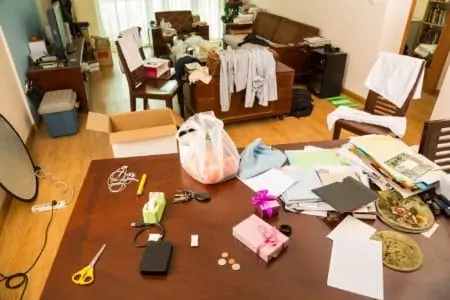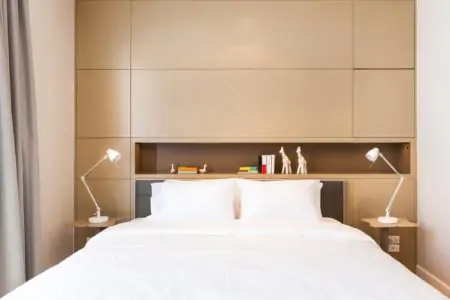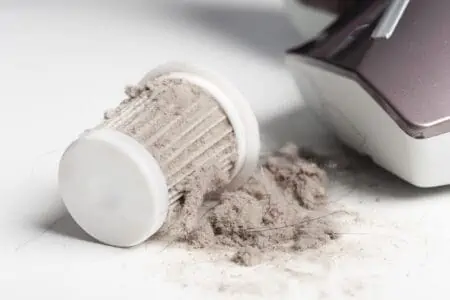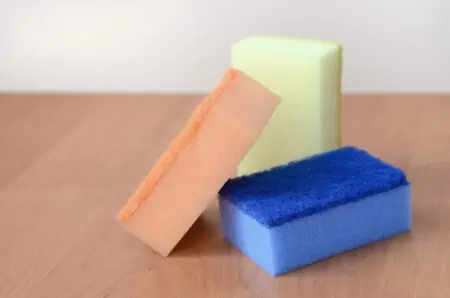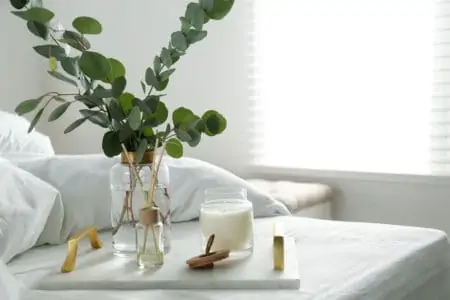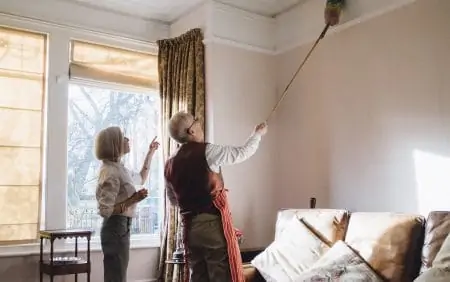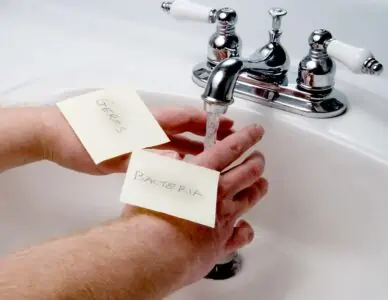Keeping a tidy home is a big challenge. One of the things that can make it even more difficult is excess clutter. I mean, who needs half a dozen takeaway menus and a bunch of old clothes taking up precious space in your home?
We’ll walk you through how to declutter your home so that it feels like a clean, fresh, and more manageable space.
You’ll also get great tips on the benefits of decluttering and how to go about it room by room. Although this can seem like a time-consuming and daunting task, it’s going to be worth every minute!
Key Takeaways
- Decluttering increases focus, makes cleaning easier, and reduces anxiety.
- Start with the smallest room and work your way up to the biggest room.
- Ask yourself important questions about each item, such as how often you use it.
- Organize your home by going room by room and area by area.
Benefits of Decluttering Your House
Wondering if this is the right way to spend your Saturday? Here are some key reasons why you may want to declutter.
1. Increases Focus
There’s scientific evidence that an uncluttered space actually increases focus (1).
So if you’re finding it hard to stay motivated and concentrated, then try decluttering.
Visual clutter can increase distractions. We definitely find ourselves thinking about how great it would be to have a good cleaning session instead of actually concentrating on the task we should be doing!
2. Cleaning Is Easier
One of our favorite benefits of decluttering is that, in the end, it makes cleaning your home easier and faster. When there’s less around to create a mess, then there’s less mess to clean up! Plus, when everything has a place, it takes the guesswork out of where to put something.
3. Home Becomes Healthier
Decluttering actually makes your home a healthier place! It reduces the chances of pet dander, mold, and dust build-up (2). Clutter is a perfect place for these nasties to hide. If you have allergies or asthma, decluttering might be just the thing to make you feel happier and healthier.
Try This
Even if you don’t have allergies or asthma, try decluttering anyway. It can still help your health and safety since excess clutter creates tripping hazards.
4. Reduces Anxiety
Another psychological benefit to decluttering is that it can reduce anxiety (3). When things are out of order, we feel anxious and overwhelmed. Creating a clean and mess-free environment can instantly make us feel a lot more chill.
5. Less Family Tension
Increased clutter can create a lot of tension between family members. If your teenagers’ shoes and school supplies are always in the way when it comes to setting the table, it can be annoying. Having a place to store these things after school and working together to reduce clutter in the first place can cut down arguments.
Also, when working together as a family, it’s easier to clean a house with minimal clutter. Plus, when everyone knows where things go, cleaning is done much quicker with less complaining.
How to Declutter Your Home
Decluttering your whole house can be overwhelming, but we’ll break it down for you. Let’s first look at these 12 tips for decluttering.
1. Make a Plan and Prep
Before you even start decluttering, you should make a plan and prepare. This is key, especially if you’re overwhelmed and don’t know where to start.
Ask yourself what your dream space looks like. If you could have a clutter-free kitchen, for instance, what would it look like? We recommend browsing through Pinterest for inspiration before getting started.
Once you’ve made a plan and are feeling motivated, prepare. Physically and mentally. Get any materials that will make it easier to declutter, such as trash bags for removing or donating items. You may also want to buy some storage bins or units for storing stuff.
Preparing mentally means giving yourself the time and space to deal with this pretty big task. It can also help to rope in some friends or family to make the experience more fun and manageable.
Top Tip
Schedule your decluttering session. Having a whole weekend to tackle this task is a good idea. If you randomly start it one day after work, you may become more overwhelmed than you were beforehand.
2. Start With the Smallest Room
When you’re ready to start decluttering, we recommend beginning with the smallest room. This may be a closet, your utility room, or maybe a bathroom.
Starting small gets you in the zone without overwhelming you. You can ease into the process!
Gradually build your way up from the smallest room to the biggest room. By the time you get there, you’ll be a decluttering pro!
3. Ask Yourself Important Questions
How do you know what to declutter? What to toss out? What to keep?
First of all, absolutely get rid of anything that is expired. This could be makeup, hair products, and even food. If it’s past its best life, say goodbye.
You should then ask yourself, “How often do I use this?” If you use it regularly, keep it! If you don’t see yourself ever using it again or even missing it, get rid of it.
Keep In Mind
There may be some things you don’t use regularly, but instead, you use them seasonally. This could be winter coats, skis, canoes, or that video camera you take on every vacation. If you know you’ll use it once a year, but not exactly regularly, do not throw it out. You’ll regret it when the time comes for you to use it again.
4. One Room At a Time
When decluttering, you may find that you move things from room to room. But you should not get distracted by the fact that some things from the living room are ending up in a pile in your bedroom. Just dump the stuff into the bedroom and finish the living room before making a start on the bedroom.
If you go randomly from room to room, your home will soon become even messier than it was to begin with! So take it slow, go one room at a time, and work at an even pace.
5. Find a System for You
There are many decluttering “experts” online, and they are great, but their system might not work for you. Many of these experts suggest having a few of a certain item. For instance, someone might suggest keeping 10 books, but if you have a home library that you love — keep it that way! Find a system that works for you, despite what the experts say.
6. Don’t Be Overly Sentimental
Some things have sentimental value and are worth keeping. But other items just don’t warrant a sentimental attachment. This is easier said than done, but once you get into a sentimental zone, it’s hard to get out of it. So try not to be overly sentimental when there’s an item that really doesn’t need to stay in your home.
Top Tip
If something is slightly sentimental but you don’t want to keep it, take a picture of the item. You’ll remember it forever without it taking up valuable space in your home.
7. Work With a Donation Center
Making a good connection with a local donation center or charity can motivate you to declutter often. You may find yourself getting into the habit of looking around your home and asking yourself what you can donate this month. This gets lots of people excited about decluttering since it means they have the opportunity to help others.
8. Consider the Item’s Condition
A great way to decide whether to keep something or toss it is to examine its condition. If it’s falling apart, nearing the end of its life, or it just doesn’t work anymore — get rid of it. There’s no point in having something broken or unusable taking up space in your home.
9. Make a “Maybe” Box
We get it. Deciding a definite “yes” or “no” when it comes to keeping something isn’t always straightforward.
Create a “Maybe” box as you go around your house for things you aren’t entirely sure about.
Ignore it for a couple of days before going back to it with fresh eyes.
10. “Does It Spark Joy?”
If you joined the Marie Kondo hype train a few years ago, you’ll be familiar with the phrase, “Does it spark joy?”
This is essentially an important question to ask yourself when deciding whether to let something go or not.
This is particularly useful when decluttering your kids’ rooms. Ask them if an item makes them happy or not. If they don’t seem too bothered, that’s a good opportunity to encourage donating the item.
11. Go Area by Area
While we mentioned going room by room, within each room, go area by area. For instance, when starting with the bathroom, start with one drawer before moving onto the next.
Then go for the bathroom cabinets and mirror cabinets before moving onto bathroom closets. Going in an order reduces the level of overwhelm that comes with decluttering.
12. Perfect Your Storage Solutions
Last but definitely not least, a great way to avoid clutter building up after you’ve spent hours decluttering is to perfect your storage solutions. For instance, having wicker baskets in each room for things you’d normally dump on tables or surfaces can change the game.
In our house, people come back home and dump out their wallets, keys, and shopping bags on the kitchen counters. But having a little basket where they can toss these things until they have time to put everything away keeps the space looking clean and tidy. You can have these little storage solutions in every room.
Decluttering Your Home: Room By Room
Now that you have 12 awesome tips for making the decluttering process more manageable, let’s get into a room-by-room guide. We’ll walk through all major rooms in your home, sharing helpful tips.
Bedroom
If you have your own home, your bedroom can easily be a minimal space. However, if you have lots of people in the family, your bedroom may quickly become a place of clutter. This is especially true for kids and teenagers, where the bedroom is their dedicated space. Here are some tips for decluttering when things have become messy:
- Clear surfaces: Start with decluttering surfaces. This includes bedside tables, dressers, windowsills, and more. These surfaces are subject to “dumping”. Clearing that mess away can instantly make your bedroom look and feel much cleaner.
- Move or remove: When looking at individual items, ask yourself if you need them. If you do, ask yourself where it belongs. Find a dedicated space for it that keeps the room looking tidy. It may be that it belongs in another room! If you don’t need the item, remove it from the home entirely.
- Purge the decor: While decluttering your bedroom, get rid of any bedroom decor that you don’t love anymore. Ask yourself, “Would I buy this now?” If not, it may be time to say goodbye to it (and perhaps treat yourself to something new).
- Closets, drawers, and clothes: We don’t know about you but in our house, clothes are what clutters up our bedrooms the most. The main reason for this is because we probably just have too many clothes. Take a whole day to purge your closet, drawers, and other piles of clothes. Get rid of anything you don’t need — you can sell it on or donate it. Organizing your closets and drawers after purging them of unnecessary clothes is a great way to minimize clutter in the future.
- Put clothes away: Everyone has that bedroom spot where they pile clothes instead of putting them away immediately. You could get in the habit of putting clothes away right away, but if you’re anything like us, that’s not always possible. Instead, pop clean clothes in a lidded wicker basket. This hides the clutter until you have time to put the clothes away, keeping your bedroom much tidier.
- Contain the clutter: There will undoubtedly be random clutter in your bedroom, such as jewelry, glasses, and other knick knacks. But have storage solutions for them. You can use things like baskets, glasses, trays and other cute things.
Expert Tip
Experts will repeat this advice time and time again: make your bed. Although it’s not really decluttering, it’s still a crucial step into making your bedroom look and feel clean. If we skip making the bed in the morning, we’re way less motivated to keep the bedroom clean the whole day.
Closet
We briefly mentioned cleaning out your bedroom closet, but let’s look at more specific tips. We’ll also discuss decluttering other closets in the home.
- Have three bins nearby: Set up bins for items you want to keep, get rid of, and put in storage. As you declutter the closet, you can put items in each of these bins. Later on, go through each bin putting things back in the closet (in an organized fashion), preparing to get rid of the items, or putting them into storage.
- The three main questions: There are three main questions you should ask yourself when deciding whether to keep something. This is best for clothes and shoes, but it also works for other items. First, ask if it fits. If it doesn’t — say goodbye. Then ask yourself if it’s damaged, torn, stained, or faded. If so, get rid of it. Lastly, ask yourself if you’ve used or worn it in the last year. If not, it might be time to part with it.
- Organize closet shelves: Get storage bins and baskets for the closet shelves. This allows everything to have a special place, making your closet much tidier. It also helps you know that everything has a dedicated space so you can stay on top of the clutter.
- Go by type: If you’re feeling overwhelmed, declutter by item type. For instance, go through all your sweaters at once. Looking at all your sweaters together helps you decide whether you really need to keep all 20 sweaters!
- In with the new, out with the old: An additional decluttering tip for closets is to get rid of an old item every time you buy a new one. This will help you stay on top of items cluttering up your closet over time.
Living Room
Clutter builds up quickly here. After all, most of us spend a lot of time in the living room. Let’s look at seven ways you can clear the clutter in the main family room:
- Remove items that don’t belong: Do a quick once over. Remove any items that don’t belong in the living room. Are there a few mugs that need to go in the dishwasher? Clothes that should be put away? Books that need to go back on the shelf?
- Remove decor you don’t love: Just like in the bedroom, remove any decor that you’ve fallen out of love with. You shouldn’t force yourself to live in a space that isn’t bringing joy anymore just because your dad’s cousin bought you that really ugly vase for your wedding years ago.
- Toy corner: If your kids play in the living room and you store their toys here, you probably have a lot of toy clutter. Take some time to go through this corner with your little one. Get rid of anything that’s broken, they don’t play with, or they don’t like. Don’t feel bad if something was a gift if your kid simply doesn’t love it. Once you’ve decluttered, make sure you keep the toys organized. Try using cute storage baskets.
- Ask yourself the big questions: As well as your kid’s toy corners, you probably have a lot of stuff in the living room that you don’t use either. For instance, you could go through your DVDs, CDs, and books. Ask yourself if you use specific items, whether it sparks joy or whether you see yourself using them in the future. If not, pass it onto a friend, sell it or donate it.
- Add storage: When daily decluttering your living room, it’s a good idea to have a space for everything. We recommend hanging up some shelves and adding some baskets. Pop things in here that you don’t really have a dedicated space for or things you don’t want out in the open. This ensures the surfaces, floors, and furniture are clutter-free while maintaining a cute aesthetic in your living room.
- Clear wires: Living room wires definitely make the space look cluttered and just not cute. It’s a good idea to hire an electrician who can work their magic in hiding your wires. They can do this by hiding wires in your wall behind the TV, for example. You can also use furniture that hides wires, or you can hide wires in cute containers or under rugs.
- Six main categories: Once you’ve done a declutter of the main corners of the living room, there may still be stuff that’s creating a mess. Go through this stuff, putting the items into one of the six main categories. This includes throwing something away, relocating the item, donating it, putting it away, giving it to someone else, or repairing the item if possible.
To help you out, here’s a list of things in your living room that you may want to get rid of or relocate:
- Family member’s personal items such as clothes, shoes, and backpacks.
- Toys kids don’t play with anymore.
- Movies, CDs, and books you don’t use.
- Decor that you’ve fallen out of love with.
- Broken or worn decor items, such as coasters, photographs, and more.
- Blankets and throw pillows that are worn or out of season.
- Magazines you’re not going to read.
- Old candles, reed diffusers, and potpourri.
- Electronics and wires that you don’t use anymore.
Kitchen
Despite most people’s experience, the kitchen doesn’t need to be a place of continuous chaos.
- Clear countertops: Start by clearing everything off the countertops and putting it away. Once the counters are clean, decide what items you want to keep on the countertops. It’s a good idea to keep 3-5 items on the counters that you use every day. The other stuff can be stored in a cabinet or the pantry.
- Relocate items: The kitchen can quickly become a dumping ground for various things. Relocate every item that can go to another room, such as mail, dog leads, laundry, and more.
- Go through each cabinet: This could take a while, but if you have the time, it’s so rewarding. Go through each cabinet, cupboard, and drawer in the kitchen. Take everything out and ask yourself if you need it. This is also a good opportunity to organize things into zones, put things into separate containers and get rid of expired food.
- Purge your appliances: While decluttering the kitchen, you may come across appliances, pots, pans, and other utensils that you never use. This is a good chance to get rid of them. If they’re still in good condition, try selling or donating them!
- Remove excess spares: Do you really need 40 plates if only two people live in the house? 25 different mugs? Get rid of excess spares that you never use.
- The junk drawer: Ah, the dreaded junk drawer. Don’t think we would have gotten through this article without reminding you that perhaps now is the time to go through the junk drawer and get rid of anything that is quite literally junk.
Here are a few things in your kitchen that you could consider decluttering:
- Cookbooks.
- Utensils.
- Baking ware.
- Old oven mitts and dish towels.
- Worn Tupperware.
- Gadgets you never use.
- Expired medicine.
Home Office
Your office needs to be a place of productivity and focus. Don’t let clutter take over.
- Start with paper: Paper can quickly clutter up your home office. Go through this first. This could include mail, documents, bills, receipts, homework, and more. Go through it, filing stuff, creating a “to-do” list, and trashing stuff you don’t need anymore.
- Declutter desk surface: Next, move onto your desk. Remove clutter on the surface. This could be mugs, snacks, old post-it notes, and more. You may want to remove everything from the desk and start over with a completely clean space. This allows you a fresh opportunity to reorganize your desk.
- Clear out desk drawers: Next, go through your desk drawers. Take everything out and put it on the floor or on another surface to go through it. Get rid of items you don’t need or use and keep everything you need. Before putting it back into the drawer, create an organizational system that works for you, such as using drawer bins.
- Go through decor: There are so many different ways to decorate your home office. Take this opportunity to get rid of any decor that makes your space feel cramped, crowded, or uninspiring.
- Keep essentials: You may find keeping only the essentials in your home office makes the space feel less overwhelming. For instance, you could keep one of each item. One pen, one pencil, one notebook, and so forth. You don’t need to toss everything else in the trash, but you could put it into storage until you next need it.
Here are some more regular home office items that you may want to get rid of:
- Old technology and software.
- Cords and wires that you don’t use or know what they’re for.
- Old and broken laptops, tablets, computer mice, keyboards, and more.
- Stationary that you don’t use or doesn’t work anymore.
- Empty ink cartridges.
- Junk mail.
- Old books or books you won’t read.
- Random knick-knacks.
Bathroom
A clutter-free minimal bathroom is easier to keep clean. Plus, it’s nicer for guests. Here are our top tips for decluttering the bathroom:
- Start with the counters: Take everything off the counters and put it in piles by category. Go through each category and decide what you need to keep and what you need to toss. A top tip is to absolutely get rid of everything that’s expired. Don’t feel guilty about getting rid of products you bought but that you don’t love, even if they’re not finished. A friend might appreciate it as a gift.
- Go through the drawers: Once you’ve done the counters, go through the drawers using the same method as above.
- Use the monthly rule: If you have a product you’re trying out but aren’t sure if it’s worth keeping, give it another month. If you haven’t fallen in love with it in the next few weeks, it’s time to get rid of it.
- Go through your towels: Believe it or not, you can have too many towels. Get rid of excess towels by donating them to an animal shelter.
- Medicine cabinet: Make sure to go through your medicine cabinet, getting rid of anything that’s out of date, expired, or no longer recommended by your doctor.
- Shower bath area: Now go through the bath and shower area, getting rid of any products that are empty or that you don’t use. You may want to keep a minimal amount of products in the shower. Put the other stuff in a little caddy in a closet. This keeps the shower area clutter-free. Each time you go for a bath or shower, simply grab what you need out of the caddy.
Garage
Take a deep breath. We know that decluttering the garage can be super overwhelming. But we’ll share a few handy tips that should make the whole process a bit easier.
- Don’t do it alone: First of all, don’t do this task alone, if you can. Grab a friend or family member who will be willing to help you out since this is such a big job. Put on some music, order some pizza and try to enjoy the experience.
- Go by area: Start by going to one area, dealing with it, and then taking a break. You don’t need to do the whole garage in one go. It might be easier to do one or two areas each day.
- Go by storage type: The next thing you should do, once you’re within an area, is go by storage type. For instance, start by decluttering stuff on a shelf. Then move onto stuff that’s stored on a surface. Then move onto stuff you keep on the floor. Lastly, go through stuff in boxes. This will make the decluttering routine more manageable.
- Three-box method: Have three bins: keep, get rid of, and storage. For stuff you want to keep, pop it in that bin. The next bin is for stuff you want to toss or donate. The last bin is for stuff you want to keep in storage outside of the garage.
- Get rid of toxic stuff: Garages can be the home for a lot of toxic clutter, such as cleaning products, oil, paint, batteries, and fertilizers. Use this as an opportunity to safely dispose of these things according to the manufacturer’s advice.
Once you’ve decluttered your garage, come up with a storage system that works for you. This will keep the garage super organized and reduce clutter build-up in the future.
Basement
Similar to the garage, the basement can be an overwhelming place to declutter. But here are some handy tips.
- Use labels: If your basement is particularly cluttered, using the three-box method may not work. Instead, use colorful labels to mark what you want to keep, toss, donate, and sell. Stick a label onto each item, then later, you can go through each color to deal with the specific items.
- Deal with the trash: Once you’ve established what is trash, get rid of that first. This will remove a lot of clutter initially.
- Section by section: Like with the other big rooms, it’s helpful to go section by section in the basement. This could be going by zones if your basement is already organized. Or it could just mean starting at one end of the basement and working your way around. Just remember to take breaks between sections, so you don’t tire yourself out.
- Use storage bins: Once you’ve decided what’s staying, reduce the clutter by putting things into storage bins. Keep categorized things together. For instance, have a box for winter clothes. Have another for summer gear. Make sure you label each box, so you know where everything is.
- Get rid of “just in case” items: It can seem like a good idea to keep that random pair of rollerskates just in case. But if you’ve not used an item in a year, there’s a good chance you won’t ever again.
Top Tip
With basements, it’s a good idea to decide what your basement is for. Is it a storage facility? Do you want to use this area for hosting parties? Is this your dream laundry station? Working out what you want to use your basement for can help you to organize the clutter effectively.
How to Prevent Clutter
Now that you’ve decluttered your home, how can you stay on top of it so that you don’t have to go through this huge process again? Here are 10 tips:
- Stop buying new stuff: Try and be more intentional about the new things you bring into your home. As fun as it is going to the thrift store and buying a ton of stuff because it’s cheap, it may clutter up your home quickly.
- Create systems: Having an effective organization plan can minimize clutter immediately. If everybody in the family knows there’s a place for mail, for instance, then it won’t clutter up the countertops.
- Declutter daily: This seems like a big ask, but clutter won’t build up if you declutter areas daily. Plus, after a few days, this may only take a few seconds each time.
- One in, one out: If you are bringing new stuff into the home, get rid of something every time you do. New pair of jeans? Get rid of that faded old pair that you’ve worn 100 times.
- Have clutter spots: For some homes, clutter is inevitable, and that’s okay. Clutter isn’t a crime. But have a spot to keep your clutter. For you, this might be a junk drawer. For others, cute baskets can disguise clutter.
- No free stuff: When you go to conventions, you may come home with a load of free stuff. Do you really need it? Next time, say no to the free stuff you’re offered.
- Put stuff away: It only takes a minute to put something away in its proper space. If you pick something up, don’t put it down. Put it away.
- Keep things where you use them: It might be tempting to create a cute little remote station on the other side of the room. But if you keep your remotes in a storage solution near your couch, you’re much less likely to leave them lying around after finishing a film. Just keep things near where you use them to minimize clutter.
- Go digital: If you opt for digital note-keeping, you’ll have a lot less paper cluttering your home.
- Negative energy: If there’s something in your home bringing negative energy, like a beloved blanket that the dog ripped up, get rid of it. It may seem hard, but it could actually bring about a more positive environment.
FAQs
Clear the Clutter
With this ultimate guide, you can clear the clutter for good. It might take you a whole weekend, but once it’s done, it’s much more manageable. With our tips and tricks, you can clear the clutter from each room and keep it that way for good. Just make sure everyone in the family is on board. And remember, clutter isn’t a crime. If you have a junk drawer that you can’t get rid of, we’re not judging.
